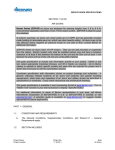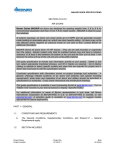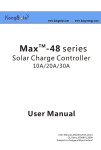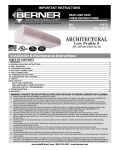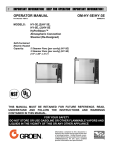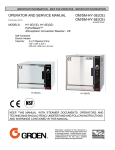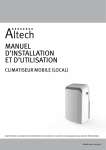Download MAX ZEPHYR INSTALLATION
Transcript
E NS V O SA T I D UC N A TR S D A N E I R E ES TH No.: Date: II-470 October, 2007 Installation & Maintenance Instructions WARNING: TO REDUCE THE RISK OF FIRE, ELECTRIC SHOCK, OR INJURY TO PERSONS, OBSERVE THE FOLLOWING: A. Use this unit only in the manner intended by the manufacturer. If you have any questions, contact the manufacturer. B. Before servicing or cleaning unit, switch power off at service panel and lock the service disconnecting means to prevent power from being switched on accidentally. When the service disconnecting means cannot be locked, securely fasten a prominent warning device, such as a tag, to the service panel. C. Installation work and electrical wiring must be done by qualified person(s) in accordance with all applicable codes and standards, including fire-rated construction. D. Sufficient air is needed for proper combustion and exhausting of gases through the flue (chimney) of fuel burning equipment to prevent back drafting. Follow the heating equipment manufacturer’s guideline and safety standards such as those published by the National Fire Protection Association (NFPA), and the American Society for Heating, Refrigeration and Air Conditioning Engineers (ASHRAE), and local code authorities. E. When cutting or drilling into wall or ceiling, do not damage electrical wiring and other hidden utilities. I. UNCRATING ACCESSORIES: If the unit(s) were ordered with optional electrical accessories (door switch, control panel, etc.), the accessories may be found in the carton containing the unit or in a separate carton(s) accompanying the unit(s). Check all of the cartons/skids for accessories before discarding. Carefully examine the carton(s) for damage before opening. If the carton is damaged, immediately notify shipping company. If the unit(s) were shipped on wooden skids, remove protective wood and banding straps securing the carton(s) to the skid. Open the carton(s) and remove all protective packaging. Immediately verify that the electrical rating nameplate located on the cover matches electrical power supply available. Retain the shipping carton(s) until the unit(s) are installed and properly operating. BERNER INTERNATIONAL CORPORATION New Castle, Pennsylvania 724-658-3551 ● 1-800-245-4455 ● www.berner.com © Copyright 2007 Berner International Corporation -1- ● [email protected] II. MOUNTING INSTRUCTIONS (General) INDOOR MOUNTING - Environmental/Insect/Dust Control OUTDOOR MOUNTING (Unheated Only)- Insect/Dust Control Zephyr/Maxair air door is designed to be an effective barrier against cold drafts in the winter and hot air in the summer. To achieve optimum protection, the unit should be mounted on the inside of the building, flush to the wall and as close to the top of the door opening as possible. To ensure peak performance keep air stream free of obstructions. The air door will not perform properly if negative air pressure exists in the building. Under these conditions, a means for makeup air to the building must be provided so that the air pressure on both sides of the opening is in balance. Before mounting the unit, check the supporting structure to verify that it has sufficient load-carrying capacity to support the weight of the unit(s). The mounting hardware (supplied by others) should be capable of supporting a minimum of three (3) times the weight of the unit. See Table 1. NOTE: The air door is weatherproof, therefore no special covering is required for outdoor mounting. IMPORTANT: A minimum of 1” is recommended above the top of the air door for the installation and removal of the cover housing. A. When determining the mounting location for the unit(s), make sure that nothing interferes with the curtain of air developed when the discharge vanes are directed from 0º to 20º toward the door opening. If the air stream strikes any obstruction (the top edge of the doorway, a door opening device, etc.), the effectiveness of the unit will be greatly reduced. See Figure 1 B. For optimum performance, the bottom of the unit (discharge nozzle) should be no more than 1” above the top of the door opening with the unit mounted flush to the wall. If the unit must be mounted higher, it must be spaced out from the wall 3/8” for every inch the unit is above the door opening. For optimum protection, any void between the air door and the wall should be sealed along the full length of the unit. C. Electric heated units shall: 1. Have a minimum clearance of at least 1” between the sides and top of the unit and any combustible material. MODEL ZPR/MAX1030 ZPR/MAX1036 ZPR/MAX1042 ZPR/MAX1048 ZPR/MAX1060 ZPR/MAX1072 ZPR/MAX2084 ZPR/MAX2096 ZPR/MAX2120 Net Weight Net Weight Ambient (lbs) Heated (lbs) 33 38 43 48 57 64 86 96 124 40.5 45.5 50 56 75 76.5 100 111.5 145.5 TABLE 1 - Unit Weight FIGURE 1 - Mounting Location 2. Have a minimum clearance of at least 6’ between the bottom of the unit and the floor. 3. Be installed indoors only. D Proceed to either Section III-WALL MOUNTING, or Section IV SUSPENDED MOUNTING III. A. The ZPR/MAX Series Air Door is equipped with two ¼” threaded inserts on the back of each unit (two per module on units 84” and over). Insert and tighten the shoulder bolts (provided) into these threaded inserts. A minimum of two shoulder bolts are required, on units comprised of modules use the outer threaded inserts and a minimum of one of the inner threaded inserts. B. Determine the exact mounting location of the air door unit. NOTE: A minimum of ¾” is required above the wall mounting plate to provide clearance for installation and removal of the unit. Net Weight Steam/Hot Water (lbs) 39 48 55 62 75 87 113 127 163 WALL MOUNTING C. The wall mounting plate (included) is designed to fit flush with the top of the ZPR/MAX Series Air Door. Therefore the location of the wall mounting plate will determine the final location of the top of the Air Door. D. Position the center of the wall mounting plate over the center of the door opening with the larger opening of the key hole slots facing up. For optimum performance, the bottom of the mounting plate should be no more than 2” or less than 1” above the top of the door opening. The wall mounting plate thickness provides a natural ¾” space which allows for mounting it up to 4” above the opening. See Figure 2 -2- rating nameplate. Remove the required knockouts and attach necessary electrical hardware. Save the wiring diagram found inside of wiring tray. See Figure 7 I. There are two sets of keyhole slots on the wall mounting plate. In low overhead installations the air door may be staged in the lower keyholes to provide clearance for electrical wiring and then moved to the higher holes after completion. Raise the air door with the discharge opening facing down toward the floor. While holding the unit level, slide the heads of the shoulder bolts into the larger hole of the keyhole slots of the mounting plate. Lower the unit into place, keeping both ends level, allowing it to rest flush with the mounting plate. See Figure 4 J. After attaching the unit to the mounting plate, ensure that the unit is seated and flush with the mounting plate on all four sides. K. Proceed to Section V - Electrical Connections. FIGURE 2 - Standard Wall Mounting If the wall mounting plate must be mounted higher than 4” above the door opening, it must be spaced out from the wall 3/8” for every additional inch (over 4”) that the unit is above the door opening. See Figure 3 For optimum protection, do not exceed the recommended maximum mounting height of 8’ above the finished floor. Any void between the mounting plate and the wall should be sealed along the full length of the mounting plate. E. Determine which of the four holes provided in each of the steel brackets of the wall mounting plate are located where suitable support is available for the unit. Minimum one inside hole and one outside hole from each bracket must be used for proper support. Drill out the aluminum backing of the holes chosen with a ¼” drill bit. If the provided holes on the mounting plate are not located where suitable support is available, drill new holes in the space provided on the steel mounting brackets. FIGURE 4 - Installing Air Door on Wall Mounting Plate F. Mark the wall in the centers of the ¼” holes drilled on the mounting plate. IV. G. Attach the mounting plate to the wall (hardware by others). SUSPENDED MOUNTING (Ceiling Suspension) H. The top of the unit is provided with two knockouts on each side allowing for a left or right hand power connection. Remove the wiring tray cover; on units that are comprised of modules, remove the wiring tray cover that is located closest to the electrical A. When the unit is top mounted, the wall mounting plate is designed to store on the back of unit for future use. See Figure 5 FIGURE 3 - High Wall Mounting FIGURE 5 - Wall Mounting Plate Storage -3- V. ELECTRICAL CONNECTIONS All electrical wiring and connections MUST be performed by qualified personnel in accordance with the National electrical Code ANSI/NFPA No. 70 (latest edition) or, in Canada, the Canadian Electrical Code, Part 1-C.S.A. Standard C22.1 and local codes and regulations. A. Check the rating nameplate on the top of the unit for supply voltage and current requirements. See Figure 7. A separate line voltage supply with a suitable branch circuit protection device should be run directly from the main electrical panel to the unit. A disconnect switch for each branch circuit is a required part of this installation. See Tables 2 & 3 B. All field wiring must be copper with a minimum insulation of 60°C within approved conduit. If any of the wire supplied with the unit must be replaced, it must be replaced with copper wiring with a minimum insulation of 90°C. C. Remove the wiring tray cover; on units that are comprised of modules, remove the wiring tray cover that is located closest to the electrical rating nameplate (if it has not already been done). FIGURE 6 - Suspended Mounting B. Four (4) factory installed ¼” threaded inserts are located on the top of the unit for top suspension mounting; on units comprised of modules use the outer threaded inserts. To eliminate the slight deflection of longer units, the inner threaded inserts may also be used. See Figure 6 D. Electric heated units are factory equipped with a unit mounted solid state temperature sensor cable (for the Intelliswitch thermostat) located in the wiring tray. Depending where the temperature is to be measured; the sensor may be left in the wiring tray or it may be located outside of the unit. If the unit is unheated, equipped with a steam/water coil or the sensor will be left in the wiring tray, skip to step E, otherwise continue. C. Determine the exact mounting location of the air door unit. Note: Sensor storage temperature range is -76º F to 302º F (60º C to 150º C). Sensor functioning temperature range is 32ºF to 100ºF (0º C to 38Cº). D. The top of the unit is provided with two knockouts on each side allowing for a left or right hand power connection. Remove the wiring tray cover; on units that are comprised of modules, remove the wiring tray cover that is located closest to the electrical rating nameplate. Remove the required knockouts and attach necessary electrical hardware. Save the wiring diagram found inside of wiring tray. See Figure 7 1. 2. Remove 1/2" bushing taped to the back of the wiring tray cover and set aside. Determine mounting location of the temperature sensor (do not mount at this time). E. Attach ¼” threaded rods, or other suitable hardware to the top mounted threaded inserts. F. Proceed to Section V - Electrical Connections Model ZPR/MAX1030 ZPR/MAX1036 ZPR/MAX1042 ZPR/MAX1048 ZPR/MAX1060 ZPR/MAX1072 ZPR/MAX2084 ZPR/MAX2096 ZPR/MAX2120 FIGURE 7 - Electrical Connections MOTOR DATA 120 V 1ø #Motors @HP Total Motor Amps 1@1/5 1@1/5 1@1/5 1@1/5 1 @1/5 1@1/5 2@1/5 2@1/5 2@1/5 3.4 3.4 3.4 3.4 3.4 3.4 6.8 6.8 6.8 TABLE 2 - Motor Amp Draw -4- 208/240 V 1ø Total Motor Amps 1.7 1.7 1.7 1.7 1.7 1.7 3.4 3.4 3.4 ELECTRIC HEATER DATA* Add total motor amp draw from Table #2 to circuit #1 for unit total amp draw 480V 3Ø** 208V 3Ø 240V 3Ø 208V 1Ø 240V 1Ø Amp Draw Amp Draw Amp Draw Amp Draw Amp Draw Circuit 1 Circuit 2 Circuit 1 Circuit 2 Circuit 1 Circuit 2 Circuit 1 Circuit 2 Circuit 1 600V 3Ø** Amp Draw Circuit 1 MODEL KW ZPR/MAX1030 5.4 26.0 N/A 22.5 N/A N/A N/A N/A N/A N/A N/A ZPR/MAX1030 7.2 34.6 N/A 30.0 N/A N/A N/A N/A N/A N/A N/A ZPR/MAX1036 10 48.0 N/A 41.7 N/A 27.8 N/A 24.1 N/A 12.0 10.0 ZPR/MAX1042 10 48.0 N/A 41.7 N/A 27.8 N/A 24.1 N/A 12.0 10.0 ZPR/MAX1048 14.4 34.6 34.6 30.0 30.0 40.0 N/A 34.6 N/A 17.3 14.6 ZPR/MAX1060 14.4 34.6 34.6 30.0 30.0 40.0 N/A 34.6 N/A 17.3 14.6 ZPR/MAX1072 20 N/A N/A N/A N/A 27.8 27.8 24.1 24.1 24.0 20.1 ZPR/MAX2084 20 N/A N/A N/A N/A 27.8 27.8 24.1 24.1 24.0 20.1 ZPR/MAX2096 28.8 N/A N/A N/A N/A 40.0 40.0 34.6 34.6 34.6 28.9 ZPR/MAX2120 28.8 N/A N/A N/A N/A 40.0 40.0 34.6 34.6 34.6 *Optional kW available. Check wiring diagram supplied with unit for kW and AMP draw if not listed above. ** Separate 120V, 208V or 240V single phase circuit required to operate motors rated in Table 2. 28.9 TABLE 3 - Electric Heater Amp Draw 3. 4. 5. Choose end of the wiring tray that the sensor will exit the unit based on mounting location from step 2. Locate the 1/8" hole on wiring tray next to the electrical knockout on the side determined in step 3. Drill out 1/8" hole to 1/2". CAUTION: DO NOT DAMAGE EXISTING WIRES IN THE WIRING TRAY WHEN DRILLING 6. 7. 8. Maneuver the tip of the temperature sensor from the inside through 1/2" hole. Thread tip through 1/2" bushing from step 1 and snap bushing into wiring tray. Mount temperature sensor. Do not put any clamps on rubber coated tip. 1. 2. 3. 4. 5. 6. E. The top of the unit has two knockouts on each side allowing for a left hand or right hand power connection. Remove the required knockout, if it has not already been done, and connect the power supply to the unit. Connect all supply and control circuit wires according to wiring diagram provided. NOTE: Polarized rib on the serial cable faces up to straddle locking ramp on 4-pin header. Ensure that all cable connections are locked onto headers. NOTE: It does not matter which port is used for either case because each serial port supports two way communication to other Intelliswitches. NOTE: For Electric heated units provided with optional remote thermostat. Mount and wire the thermostat according to instructions and wiring diagram. 7. F. Master/Slave connection, if two or more units are to be linked together for master/slave operation continue, otherwise skip to step G. NOTE: One Intelliswitch serial cable (part no. 505SC485INT) is required for every unit that is to be used as a slave. For master/slave operation a serial cable connection must be made between the Intelliswitch control boards of each unit to be linked. -5- Disconnect the power to all units. Access the Intelliswitch control board by removing two phillips head screws from the Intelliswitch display faceplate. Remove the faceplate from the control board by grasping it firmly and gently pulling it away from the unit. Locate 1" hole in wiring tray directly above control board. Guide one end of serial cable(s) through this hole, behind the motor and over the control board. Locate the two 4-pin headers (four pin male connectors) marked J4 and J5 positioned to the right of the 8-pin header for the display board. For the first and last unit connect serial cable to either J4 or J5. For each unit in between connect one serial cable to J4 and one serial cable to J5. Reinstall display faceplate by aligning 8-pin socket holes on the back of display board with 8-pin header on control board. Push gently and firmly (confirming all pins are inserted) until face plate rests against mounting bracket. Insert and tighten two phillips head screws. NOTE: Align faceplate mounting holes with threaded mounting holes on unit before pushing faceplate onto pins. This should help to align the pins with the socket. 8. The units are now linked in a Master/Slave configuration. For operation of units in a Master/Slave configuration see Section IV Operation and Controls. j. Locate male end of ribbon cable and run it to the remote display location. The cable is minimum CL2 rated and should not need to be in conduit. k. Connect the male end of the ribbon cable to the 8-pin socket through the back of the display board with the cable approaching from the bottom and the red ribbon indicator to the right (when facing the back of the display board). l. Mount remote faceplate to wall. m. Install blank switch cover onto unit using screws from faceplate. G. Remote mounted Display Faceplate, if operation of the Intelliswitch is desired through a remote mounted display faceplate continue, otherwise skip to step H. NOTE: Maximum mounting distance between the display faceplate and the unit is 20’. If the unit was factory ordered with the remote mounted faceplate option then proceed to step 1, to field convert a unit mounted Display Faceplate to a remote mount proceed to step 2. 1. Factory Ordered Remote Mounted Display Faceplate a. When the remote faceplate option is ordered from the factory the unit comes equipped with the blank faceplate and 12' ribbon attached. The display faceplate is shipped loose ready for field installation. b. Locate the male end of the 8-conductor ribbon cable in the wiring tray and run it to the remote display location. The cable is minimum CL2 rated and should not need to be in conduit. c. Connect the male end of the ribbon cable to the 8-pin socket through the back of the display board with the cable approaching from the bottom and the red ribbon indicator to the right (when facing the back of the display board). d. Mount remote faceplate to the wall. 2. Field Conversion of Unit Mounted Display Faceplate to Remote Mount H. Reinstall wiring tray cover. I. Proceed to Section VI-Mechanical Connections for Electric, Steam and Hot Water units other wise proceed to Section VIIOperation and Controls. VI. MECHANICAL CONNECTIONS A. ELECTRICALLYHEATED MODELS The heater circuit may be controlled by a remote thermostat or manually through the switch located on the discharge side of the unit. Overheating protection is provided by auto reset thermal cutouts built into the heater coil assembly (see the wiring diagram). B. STEAM OR HOT WATER HEATED MODELS Piping should be done in accordance with local codes, regulations and standard practices. Connect the building system supply & return to the ¾” MPT nipples on the heating coil. See Figure 8 NOTE: One Intelliswitch remote mounting kit (PART # 33G020RDK-A) is required for every unit that will have a remote mounted faceplate. a. Disconnect the power to all units. b. Access the Intelliswitch control board by removing two phillips head screws from the Intelliswitch display faceplate. Remove the faceplate from the control board by grasping it firmly and gently pulling it away from the unit. c. Flip the faceplate over and place it on a clean soft surface. d. Remove the two phillips head screws holding the display board to the faceplate. If one of the screws uses two fiber washers, save them for the replacement board. e. Install display board onto remote faceplate with existing screws and washers. f. Locate 1" hole in wiring tray directly above control board. g. Guide the female end of the 8-conductor ribbon cable through this hole, behind the motor and over the control board. h. Locate the 8-pin header for the display board on the control board marked J1. i. Connect female end of the ribbon cable to 8-pin header on the control board with red ribbon indicator located on the left for pin #1. FIGURE 8 - Steam/Hot Water Connections VII. OPERATION AND CONTROLS A. The Intelliswitch is a user programmable microprocessor controller that lets the user control all aspects of the Zephyr/ Maxair air door. 1. Unit/Remote Mounted Display Press “Menu” button to navigate features Press “Arrows” to adjust/change settings, all settings rollover -6- b. 3. External Connections a. Remote Mounted Thermostat: A remote mounted thermostat may be connected to wires 6 & 7 of the Intelliswitch. If the internal thermostat is left on, the external thermostat will work with it in parallel, allowing either one to activate the heat. If the internal thermostat is turned off, the external thermostat will work independently to activate the heat. b. Auto Mode Activation: The Intelliswitch may be activated externally through the Auto mode by means of an external set of dry contacts (typically a door switch) connected to wires 9 & 10. NOTE: hold arrow down to scroll values faster for time and temperature settings NOTE: If after any Menu or setting change there is no activity for 15 seconds the control will save changes and default back to display clock. • • • • • Lock/Unlock: hold up and down arrows simultaneously for 10 seconds to lock control (when locked, features maybe viewed, but settings cannot be changed) Fan Speed: settings range from 1 thru 10 (1=low speed, 10=high speed) Mode: Off - unit off On - unit will come on when Start/Stop Time is satisfied (see below) Auto - unit will come on with external contact closure (typically a door switch) and when Start/Stop Time is satisfied (see below), unit will shut off when external contact opens Delay Time: settings range from 1 second - 10 minutes in increments of seconds, active in Auto mode only, this will delay the time that it takes the unit to turn off after the external contact opens NOTE: Set to “Off” position to disable Temp Set: First - temperature units setting (F - Fahrenheit, C Celsius) Second - temperature settings range from 50º - 90º F (10º32º C), displays temperature setting for built in thermostat (when temperature falls below setting, heat will come on) • • 2. Master/Slave Operation For master/slave operation a serial cable connection must be made between the Intelliswitch control boards of each unit to be linked. Once units are linked, all Menu setting changes made on all units through the display faceplate or hand held remote will transfer to all other linked units. NOTE: Changes do not take effect until the Menu button is pressed to advance to the next option or after the control returns to clock display. B. Rotary Variable Switch Control Rotate the dial counter clockwise to turn on the unit. Fan speed starts at high and decreases to low. The heat will also be energized on units with an optional electric heater. A thermostat may be used to cycle the heat on and off. VIII. AIRFLOW ADJUSTMENTS A. With the air door operating and the door in its full open position, check to see that nothing is obstructing the air flow at the discharge nozzle vanes. NOTE: The internal thermostat may be disabled by setting it to the off position located between the 90º and 50º (32º and 10º C) settings • 4. The hand held remote will change any of the settings when the display is locked. Start Time: sets the time when the unit is to turn on in the “On” mode or become active for “Auto” mode (based on time clock setting, note the “am” indicator) Stop Time: sets the time when the unit is to turn off in the “On” mode or become inactive for the “Auto” mode (based on time clock setting, note the “am” indicator) Set Time: sets the clock (note “am” indicator), does not adjust for daylight savings B. Find the air stream split location. Hold a handkerchief, by its corners, approximately 12” above the floor. Gently move the handkerchief back and forth in the doorway. Make sure the air is being directed to both the inside and the outside. See Figure 9. The split location is indicated where the handkerchief is vertical with minimal or no fluttering. C. Adjust the discharge nozzle vanes so the split location is approximately 3” outside the doorway. Adjust the speed controller so that the split location is approximately 12” above the floor. Hand Held Infrared Remote Control IX. MAINTENANCE AND CLEANING Operation of the hand held remote is the same as the Unit/Remote Mounted Display with two exceptions. a. CAUTION: ELECTRIC SHOCK HAZARD Disconnect power whenever servicing unit. More than one disconnect may be required to de-energize unit. The addition of a lock button to lock the display board. -7- B. Remove the bottom access panel by removing the phillips head screws on the bottom of the unit. C. Vacuum and scrape (if necessary) to remove the buildup of dirt and debris. The motor(s) are permanently lubricated and require no additional lubrication. Reinstall the cover and intake grille. D. Switch the power on after cleaning. CAUTION: STAND CLEAR OF THE UNIT OR WEAR SAFETY GOGGLES AS LOOSE DEBRIS MAY BE PRESENT AND MAY EXIT THE NOZZLE. X. SERVICE CAUTION: ELECTRIC SHOCK HAZARD Disconnect power whenever servicing unit. More than one disconnect may be required to de-energize unit. Any service performed on the ZPR/MAX Series air door MUST be done by qualified personnel. Berner air doors require very little servicing. All parts are easily accessible for periodic inspection and maintenance. Units should be cleaned at least twice a year. Your particular application (the amount of dirt and dust in the air) and location of the unit(s) will determine how often your unit(s) will need to be cleaned and serviced. All motors have permanently lubricated, sealed, sleeve bearings and require no maintenance. See Figure 11 FIGURE 9 - Airflow Adjustment Keep your air door operating at peak efficiency by cleaning the blower wheels, motor(s) and intake grille. Buildup of dust on the blower wheels can cause vibration, noise and excessive wear on the motor bearings. The frequency of cleaning will depend on the environment where the unit is operating. Dirty, dusty or greasy environments could require a cleaning schedule of once every two months. If the environment is not that dirty, the unit(s) should be scheduled for cleaning a minimum of once every (6) months. To access the interior of the unit: A. Disconnect the power to the unit; remove the intake grille by removing the locking screws on each end of the unit. Lift the intake grille up and then towards you. See Figure 10. FIGURE 11 - Unit Components A. INTELLISWITCH DISPLAY BOARD REMOVAL OR REPLACEMENT CAUTION: Do not expose the bare board to static electricity, water, extreme heat or extreme moisture. 1. 2. 3. 4. 5. 6. 7. 8. FIGURE 10- Intake Grill Removal -8- Set Intelliswitch mode to off. Disconnect power to the unit. Remove the two phillips head screws from the Intelliswitch display faceplate. Remove the faceplate from the control board by grasping it firmly and gently pulling it away from the unit. Flip the faceplate over and place it on a clean soft surface. Remove the two phillips head screws holding the display board to the faceplate. If one of the screws uses two fiber washers, save them for the replacement board. Install new display board onto faceplate with existing screws and washers. Reinstall display faceplate by aligning 8-pin socket holes on back of display board with 8-pin header on control board. Push gently and firmly (confirming all pins are inserted) until face plate rests against mounting bracket. Insert and tighten two phillips head screws. Note: Align faceplate mounting holes with threaded mounting holes on unit before pushing faceplate onto pins. This should help to align the pins with the socket. B. INTELLISWITCH CONTROL BOARD REMOVAL OR REPLACEMENT CAUTION: Do not expose the bare board to static electricity, water, extreme heat or extreme moisture. NOTE: The Intelliswitch Control Board may be removed without removing the bottom access cover or transverse. However removal of the bottom access cover and transverse will simplify the process. 1. 2. 3. Set Intelliswitch mode to off. Disconnect power to the unit. Remove the two phillips head screws from the Intelliswitch display faceplate. 4. Remove the faceplate from the control board by grasping it firmly and gently pulling it away from the unit. 5. Mark and remove all wires connected to the control board. 6. Remove the two phillips head mounting screws that attach the control board to the unit frame. 7. Carefully maneuver the control board out of the unit by sliding straight down. Avoid contact between board components and the motor mount. 8. Remove the two phillips head screws that attach the control board to the mounting bracket. 9. Attach mounting bracket to the new control board with existing screws. 10. Install new control board into the unit by carefully sliding the two tabs at the top of the control board into the two corresponding slots in the unit frame and fasten with flat head screws. Note: when the tabs of the board hit the unit frame tip the board up and angle the tabs into the slots. 11. Reconnect all wires to the control board. 12. Reinstall display faceplate by aligning 8-pin socket holes on back of display board with 8-pin header on control board. Push gently and firmly (confirming all pins are inserted) until face plate rests against mounting bracket. Insert and tighten two phillips head screws. NOTE: Align faceplate mounting holes with threaded mounting holes on unit before pushing faceplate onto pins. This should help to align the pins with the socket. C. INTELLISWITCH SPEED SENSOR REPLACEMENT 1. Set Intelliswitch mode to off. 2. Disconnect power to the unit 3. Remove the intake grille by removing the locking screws on each end of the unit. Lift the intake grille up and then away from the unit. 4. Remove the bottom access panel by removing the phillips head screws on the bottom of the unit. -9- 5. Remove the two phillips head screws from the Intelliswitch display faceplate. 6. Remove the faceplate from the control board by grasping it firmly and gently pulling it away from the unit. 7. Disconnect the speed sensor from the control board by locating the pin connection marked J2 and labeled PROXIMITY. Grasp the socket and carefully pull away from the control board. 8. Remove the 13 mm hex nut and washer closest to the fan from the sensor. 9. Remove the sensor. 10. Connect the new sensor to the control board, secure all loose wires from rotating parts. 11. Install new sensor into mounting bracket. Use the 13 mm nuts to position the tip of the sensor a maximum of 5/64" (2 mm) away from the rotating trigger located on the motor shaft. When the unit is energized, the LED on the back of the sensor will illuminate when the trigger passes if the correct distance has been set. CAUTION: Do not mount the speed sensor too close to the trigger, the sensor will be ruined if it is struck by the trigger. 12. Reinstall display faceplate by aligning 8-pin socket holes on back of display board with 8-pin header on control board. Push gently and firmly (confirming all pins are inserted) until face plate rests against mounting bracket. Insert and tighten two phillips head screws. NOTE: Align faceplate mounting holes with threaded mounting holes on unit before pushing faceplate onto pins. This should help to align the pins with the socket. 13. Reinstall remaining components in reverse order of removal. D. INTELLISWITCH SPEED SENSOR ADJUSTMENT 1. 2. 3. 4. 5. 6. Set Intelliswitch mode to off. Disconnect power to the unit Remove the intake grille by removing the locking screws on each end of the unit. Lift the intake grille up and then away from the unit. Remove the bottom access panel by removing the phillips head screws on the bottom of the unit. The speed sensor is held in with two 13 mm hex nuts and a star washer. Use the 13 mm nuts to position the tip of the sensor a maximum of 5/64" (2 mm) away from the rotating trigger located on the motor shaft. When the unit is energized, the LED on the back of the sensor will illuminate when the trigger passes if the correct distance has been set. CAUTION: Do not mount the speed sensor too close to the trigger, the sensor will be ruined if it is struck by the trigger. 7. Reinstall remaining components in reverse order of removal. E. INTELLISWITCH TEMPERATURE SENSOR REPLACEMENT G. 1. 2. 3. 1. 2. 3. Set Intelliswitch mode to off. Disconnect power to the unit. Remove the two phillips head screws from the Intelliswitch display faceplate. 4. Remove the faceplate from the control board by grasping it firmly and gently pulling it away from the unit. 5. Disconnect the temperature sensor from the control board by locating the pin connection marked J3 and labeled TEMP. Grasp the socket and carefully pull away from the control board. 6. Remove the wiring tray cover. 7. Cut necessary cable ties. 8. Remove the temperature sensor. 9. Install new temperature sensor and all necessary cable ties. 10. Reinstall display faceplate by aligning 8-pin socket holes on back of display board with 8-pin header on control board. Push gently and firmly (confirming all pins are inserted) until face plate rests against mounting bracket. Insert and tighten two phillips head screws. 4. 5. 6. 7. 8. 9. 10. 11. NOTE: Align faceplate mounting holes with threaded mounting holes on unit before pushing faceplate onto pins. This should help to align the pins with the socket. 12. 11. Reinstall remaining components in reverse order. F. FANAND MOTOR REMOVAL 13. UNIT MOUNTED ROTARY SWITCH REMOVAL The variable speed switch can be removed directly from the bottom of the unit. 14. 1. 2. 15. 3. 4. 5. 6. Disconnect power to the unit. Firmly grip the knob on the switch and gently pull to remove. Use a phillips head screwdriver to remove the two screws from the name plate. Remove the two phillips head screws holding the switch to the unit. Remove the switch by pushing it into the unit and rotating it gently end over end and sliding it out of the opening. Reinstall in reverse order of removal. Set Intelliswitch mode to off. Disconnect power to the unit. Remove the intake grille by removing the locking screws on each end of the unit. Lift the intake grille up and then away from the unit. Remove the bottom access panel by removing the phillips head screws on the bottom of the unit. Remove the transverse by removing the four(4) 5/16” hex washer head bolts. Rotate the speed sensor bracket away from the motor by removing the phillips screw farthest from the motor and loosening the second phillips screw. Do not remove the speed sensor from the bracket. Unplug motor harness from motor and remove necessary wiring. Using a 1/8” Allen wrench, loosen each set screw attaching fan(s) to motor. While holding the motor in place, loosen and remove the motor clips. Slide the fans toward the motor so that the ball bearings on the outer fan shaft are exposed. Slowly roll the motor out of the motor mount cradle forward and down. The hubs of the fans are flexible enough to allow the motor to move before the fans’ outer ball bearings pull out of the unit. If the unit equipped with an intelliswitch, remove the trigger bar from the motor shaft with a 5/64” allen wrench. Install the trigger bar on the replacement motor so that it is not closer than 0.030” to the motor bearing cap (including shaft movement). Ensure the trigger does not contact the speed sensor. Maximum gap distance between trigger and sensor is 5/ 64” (2mm). Reinstall in reverse order of removal. H. REPLACEMENTOFELECTRIC HEATER ELEMENT 1. 2. 3. 4. 5. 6. - 10 - Disconnect power to the unit, remove the intake grille by removing the locking screws on each end of the unit. Lift the intake grille up and away from the unit. Remove the bottom access panel by removing the phillips head screws on the bottom of the unit. Remove and mark all wires from damaged element. To remove damaged element from unit, drill out rivets and remove screws. Install new element and connect all wires. Reinstall cover and intake grille. TROUBLESHOOTING SYMPTOMS NO AIR CAUSE • Power supply line open (no power) • • • Fuse blown/circuit breaker tripped Motor overload tripped • • • Failed switch MOTOR RUNNING/FANS ARE NOT ROTATING • Broken or damaged flexible hub • Shaft rotating inside fan REMEDY • Check power source, check method of control in ON position Replace fuse(s)/reset breaker Internally protected motor - should reset automatically after cool-down, if not, replace motor. Replace switch • • Replace fan sleeve/reengage coupling Tighten set screws/tighten fan on shaft ELECTRICAL CONTROLS NOT FUNCTIONING WHEN DOOR IS OPEN • Turn switch to “ON” position Selector switch is in off position • Repair or replace limit switch Door limit switch not operating • • • • • • • • • Adjust vanes to proper position, see instructions Move air curtain or remove obstruction Provide adequate space for air curtain Improper voltage Free fan from housing Clean and vacuum fan wheels Check fans for blade curve toward discharge Speed sensor not detecting trigger rotation • Adjust gap between sensor & trigger/ replace sensor • Air stream too weak • • Air steam hits obstruction • • Negative pressure • Adjust nozzle to proper position, adjust motor speed; see installation instructions Remove obstruction or reposition air curtain (move out 3/8” for every 1” up from the door) Relieve negative pressure by providing makeup air UNEVEN AIR • • Shaft rotating inside fan One motor not operating • • Tighten set screws Repair or replace motor EXCESSIVE AIR MOVEMENT AT DOORWAY • • • • Nozzle not angled out far enough Unit too powerful Air movement too cold Pushing air outside building • • • • Adjust nozzle angle to outside Adjust motor speed Add auxiliary heat to overcome wind chill factor Adjust discharge angle back into building, adjust motor speed • • Air directional discharge vanes mis-adjusted Inadequate intake clearance • • • • Blower motor operates below speed Fan rubbing against housing Fan wheels clogged with dirt Fan in backwards NO SPEED ADJUSTMENT • AIR IS NOT HITTING FLOOR MINIMUM AIR SEE AIR IS NOT HITTING FLOOR SYMPTOMS ELECTRICALLY HEATED MODELS • • • • • • • Switch turned to “ON” position Thermostat not set properly Coils burned out due to lack of air Automatic reset thermal cutout failed in open position Manual reset thermal cutout tripped (if supplied) Speed sensor not detecting trigger rotation Without speed adjustment, failed speed sensor • • • • • • • Replace switch or check wiring Change thermostat setting Correct airflow problem; replace coils Replace automatic thermal cutout Reset manual thermal cutout Adjust gap between sensor and trigger Replace speed sensor • • Move thermostat away from air stream • • • Thermostat in wrong location - thermostat too close to discharge Improper voltage Thermostat not set properly Speed sensor not detecting trigger rotation • • • Supply proper voltage Change temperature setting Adjust gap between sensor & trigger/replace sensor • • • • • Incorrect speed range Thermostat in wrong location Thermostat not set properly Insufficient air over coil Improper voltage • • • • • Set dip switch to electric heated speed range Move the thermostat closer to air stream Change temperature setting Remove restriction on intake Supply proper voltage EXCESSIVE HEAT • • Too high steam/hot water pressure Inadequate air flow, fins plugged up, dirty coils • • Reduce steam pressure/hot water flow Clean intake and coils MINIMAL HEAT • • • Insufficient removal of condensation (steam) Not enough steam pressure/water temperature too low Intake air below design temperature • • • Increase trap size Raise pressure for steam/increase water flow Increase steam pressure/increase water flow NO HEAT MINIMAL HEAT EXCESSIVE HEAT STEAM/HOT WATER HEATED UNITS - 11 - WARRANTY Berner International warrants all new equipment to be free of defects in workmanship and material for a period of five years (5 years) on unheated models and two years (2 years) on heated models from the original date of shipment, provided the equipment has been properly cared for, installed and operated in accordance with the limits specified on the nameplate and The Company’s instructions. The Company will correct by repair or replacement, at its option and expense, any proven defects in said apparatus, subject to the above conditions, provided that immediate written notice of such defects is given to the Company. The warranty does not include any labor incurred for the removal or installation of defective part(s). The Company reserves the right to inspect, or have inspected by a qualified representative, any apparatus at the place of installation before authorizing repair or replacement. Repair or replacement will be made F.O.B. factory with any applicable transportation charges to be borne by the customer. Merchandise not of the Company’s manufacture supplied in piece, or in component assemblies, is not covered by the above warranty, but the Company will give the customer the benefit of any adjustment as made with the Manufacturer. This warranty is void if the apparatus has been tampered with in any way or shows evidence of misuse. The Company will not assume any expense or liability for repairs made outside its factory without proper written consent from its service manager, nor for any transportation charges on apparatus returned to the factory without written authorization by the Company. Nothing in the above warranty provisions, however, shall impose any liability or obligation of any type, nature or description upon Berner International if Berner has not received payment in full for the apparatus in question. THEREARE NO WARRANTIES WHICH EXTEND BEYOND THE DESCRIPTION ON THE FACE HEREOF INCLUDING THE IMPLIED WARRANTY OF MERCHANTABILITYAND FITNESS FOR A PARTICULAR PURPOSE. LIMITATION OF DAMAGES Notwithstanding anything to the contrary above, customer’s exclusive remedy for any and all losses or damages resulting from the sale of The Company’s equipment under this agreement, including but not limited to, any allegations of breach of warranty, breach of contract, negligence or strict liability, shall be limited, at The Company’s option, to either the return of the purchase price or the replacement of the particular equipment for which a claim is made and proved. In no event shall The Company be liable for any special, consequential, incidental or indirect losses or damages from the sale of The Company’s equipment under this agreement. © Copyright 2007, Berner International Corporation ● New Castle, PA ● 724-658-3551 ● Berner International Corporation New Castle, PA 724-658-3551 1-800-245-4455 www.berner.com - 12 - 1-800-245-4455 ● www.berner.com












